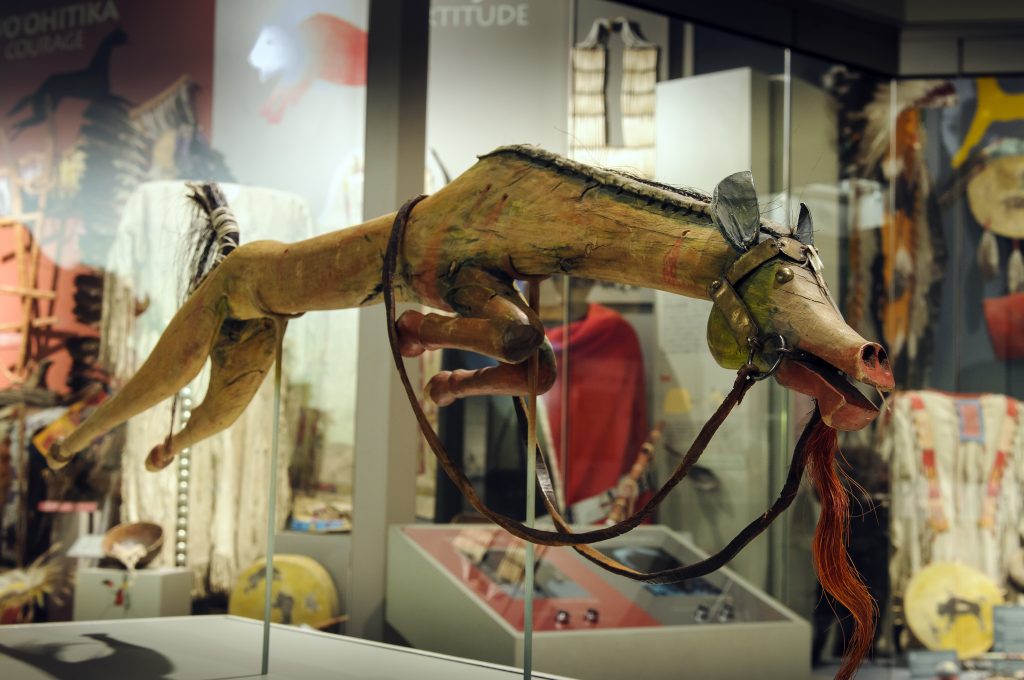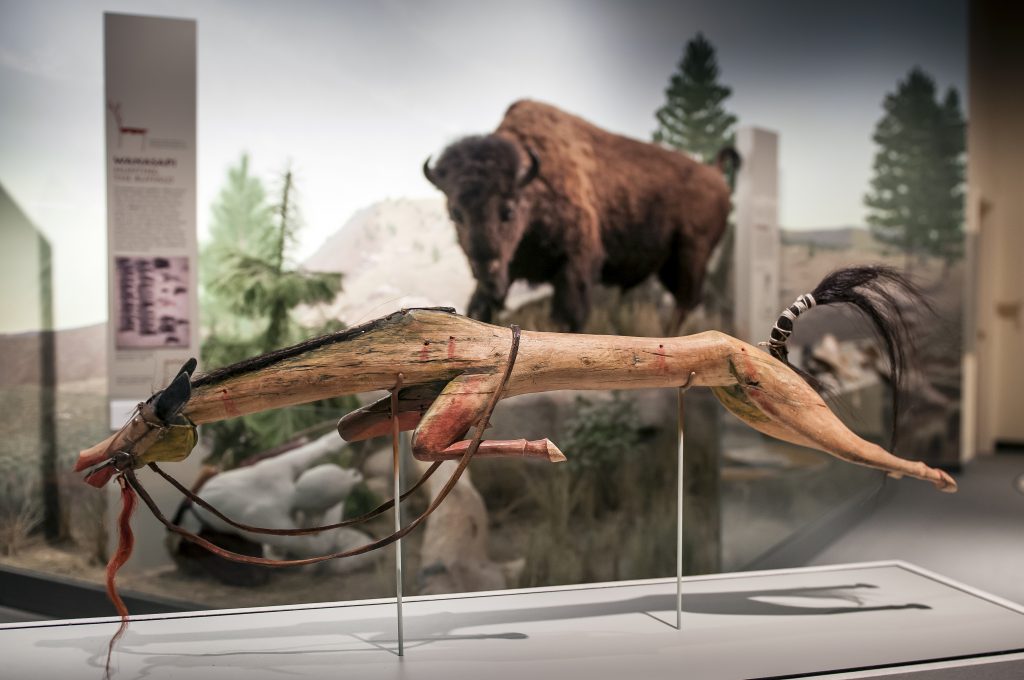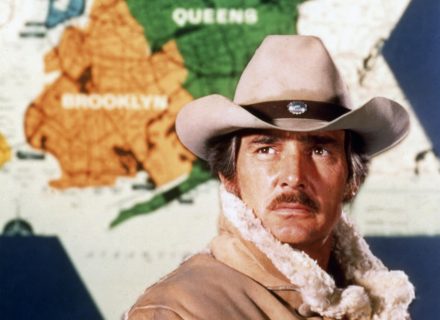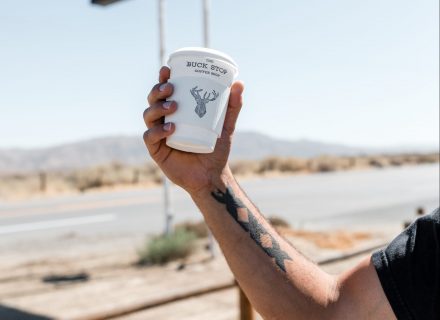In the heart of the Museum of the South Dakota State Historical Society is a Lakota warrior artist's homage to the war horse.
It’s a masterpiece of Plains Indian art, a Lakota warrior artist’s lament in wood for a war horse that died in a volley of gunfire while carrying its rider into battle, possibly at Little Bighorn. The horse’s ears are laid back in fear, blood is flowing from its mouth and seeping from no less than 10 bullet wounds, and its body twists slightly to one side as it vaults into certain death.
Carved from a single piece of wood a few years after the Little Bighorn, a battle in which the artist very likely fought, the 3-foot-long sculpture is one of the most highly prized items in the collection of the Museum of the South Dakota State Historical Society in Pierre. The artist’s finishing touches include leather ears and reins, a copper bridle, and a mane and tail made from real horsehair. Painted horsehair is used to depict blood issuing from the slain animal’s mouth.
“Carvings of this kind were known as horse memorials,” says Gaylord Torrence, curator emeritus of American Indian art at The Nelson-Atkins Museum of Art in Kansas City, one of the venues where the horse has been displayed as a part of significant exhibitions. “They were intended to honor animals that were slain in war that were companions to the warrior. They were used in ceremonies to narrate the exploits of the horse and warrior.”
The piece also evokes a vanishing way of life — especially if it honors a horse killed in 1876: That year of the Plains warriors’ best-known triumph against the whites is also the year the whites began to rein in the equestrian nations of the Plains by confiscating weapons, ammunition, and especially, horses from the Lakotas and their allies. That is the context in which a Lakota veteran of some of those major battles with the whites sat down to carve the likeness of a beloved companion in war.
Torrence doesn’t use the word masterpiece lightly, but he says this is one. He believes the piece was carved in about 1880. Torrence and probably most other scholars who have studied the piece think it is the work of a Hunkpapa Lakota warrior named No Two Horns, a cousin of Sitting Bull who is known to have carved several other horse memorials. Torrence believes the South Dakota horse is the first such work by No Two Horns, probably made after the summer of 1876 and before Sitting Bull’s surrender in 1881.
“The elaboration of the South Dakota horse, the wear that it has from handling, the weathering, this suggests to me that it was done when he was still living a nomadic life,” Torrence says.
No Two Horns was a ledger artist as well as a carver. One of his ledger drawings from about 1915, now part of the collection of the State Historical Society of North Dakota in Bismarck, shows a blue roan horse being shot from under him in what is believed to be the Battle of the Little Bighorn on June 25, 1876. The drawing shows No Two Horns wounded in the leg as the horse bleeds to death.
Torrence believes the carving and the later ledger drawing depict the same event and the same horse. He points out that the carving, although it is now mostly the natural color of the wood, has significant remnants of blue pigment along the jaw, the mane, and in the depressions in the wood. That indicates the horse was once painted blue but with a fragile pigment that didn’t adhere well to the wood, Torrence says. He also notes there are no traces of paint on a rectangular patch of wood on the forehead, perhaps left bare by the carver to suggest the white blaze on the blue roan war horse as depicted in the 1915 drawing.
Not everyone is convinced it is the work of No Two Horns, though. There has been controversy over the way the hooves were carved compared with other carvings attributed to No Two Horns and over the number of bullet wounds represented in the various depictions of the horse by No Two Horns. Torrence argues that a warrior who is still under intense fire would hardly have taken the time to make a precise count of the wounds on the horse and that the carvings and drawings he created were simply intended to show an animal that had been hit multiple times with a barrage of gunfire.
It is known that the piece was collected by Congregationalist missionary Mary C. Collins sometime between 1885 and 1910. Although Collins left no known record of how she acquired the horse carving, she was active on the Standing Rock Indian Reservation, and she was a friend of Sitting Bull. She could easily have encountered Sitting Bull’s artist cousin, No Two Horns, through him.
In an interview with his nephew in 1928, No Two Horns said that he had three horses killed in battle, one by the whites and two by the Crow Indians. But the massive concentration of firepower directed against the horse depicted in the sculpture suggests the animal may very likely have been killed in battle with the whites.
If the carving does not show a horse killed at Little Bighorn, one plausible alternative is that it shows a horse killed at the Battle of the Rosebud, on June 17, 1876, days before Little Bighorn, where the toll on horses was staggering. Journalist Robert E. Strahorn was an observer at that battle and reports the troops fired more than 10,000 rounds. It was estimated the Sioux and their allies may have fired from about one-third to one-half as many.
Strahorn’s account for the Weekly Rocky Mountain News of Denver suggests exactly the sort of scenario that could have produced the barrage of wounds the Lakota artist shows in the horse carving: “The Sioux were all splendidly mounted, and so long as pressed did much of their fighting on horseback. Some of the most reckless feats of equestrianism imaginable were performed by them within range of the broadsides of an entire company.” He goes on to say that the Sioux “lost many ponies that were either shot or captured through their reckless riding,” and he describes one such incident: “An Indian riding along the edge of a bluff was, with his pony, made the target for dozens of rifles, and rider, pony and all finally tumbled head over heels down the hillside.”
The battle was devastating for horses on both sides. The Crow warrior Plenty-coups was one of the Crow scouts fighting with the whites at the Battle of the Rosebud and later recalled he had two horses shot from under him that day as the Sioux, Cheyenne, and Arapahoe warriors pressed the white soldiers and their Crow and Shoshone scouts.
“I saw horse after horse go down and many a soldier go under, before the horse-soldiers began to run, so mixed up with Indians and plunging horses we dared not shoot that way,” Plenty-coups told his biographer, Frank B. Linderman. The aftermath of the battle was grim. “We found many wounded soldiers in the bushes, and the dead horses I shall never forget. They were everywhere, often with wounded soldiers between them on the ground,” Plenty-coups said.
After the battle, Plenty-coups added, the Crow had trouble keeping their horses safe in their nearby villages. “The Sioux, Cheyenne, and Arapahoe needed horses very badly, and almost every night they came here to steal some of ours.”
Lakota historian Josephine Waggoner, who was a child on the Standing Rock Indian Reservation at the time of Little Bighorn, remembers that after the battles of the Rosebud and Little Bighorn, the federal troops began gathering horses (“a black mass of moving horses, thousands of them”), guns, and ammunition from reservation Indians. Some horses were taken to Minneapolis to be sold, others to Omaha, Nebraska, as the work continued through fall 1876 and into 1877. For the Lakotas, it was like losing mothers and fathers or beloved children, Waggoner wrote later.
Plenty-coups, the Crow warrior, realized there was a vast difference from the whites in Plains Indians’ attitude toward horses, and he summed it up for his biographer, Linderman: “My horse fights with me and fasts with me, because if he is to carry me in battle he must know my heart and I must know his or we shall never become brothers. I have been told that the white man, who is almost a god, and yet a great fool, does not believe that the horse has a spirit [soul]. This cannot be true. I have many times seen my horse’s soul in his eyes.”
The federal government’s actions starting in the last half of 1876 seem to suggest an exasperated realization that the horse, and the Plains Indians’ special relationship with the horse, were at the heart of its ongoing difficulties with the Sioux.
It’s that context that makes the horse carving by the Lakota warrior so poignant for contemporary viewers. It’s a testament in wood to the valor of a great war horse from a time when warriors were realizing a day was coming when there would be no more war horses to celebrate.
“The effigy,” says South Dakota state historian Ben Jones, “is a celebration of courage for a time when even this kind of courage was not enough.”
The Horse Effigy equestrian sculpture is on view at the Museum of the South Dakota State Historical Society in Pierre. An artist’s rendering of the piece serves as the logo of the historical society. history.sd.gov



















